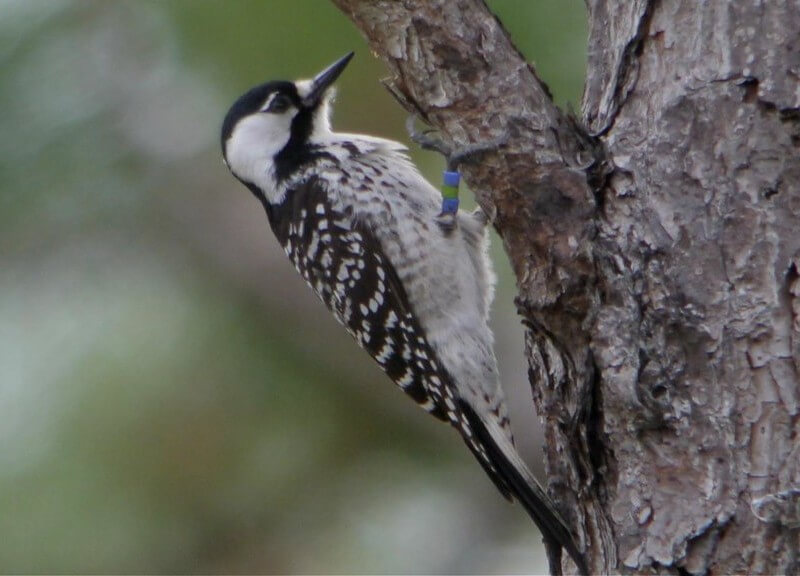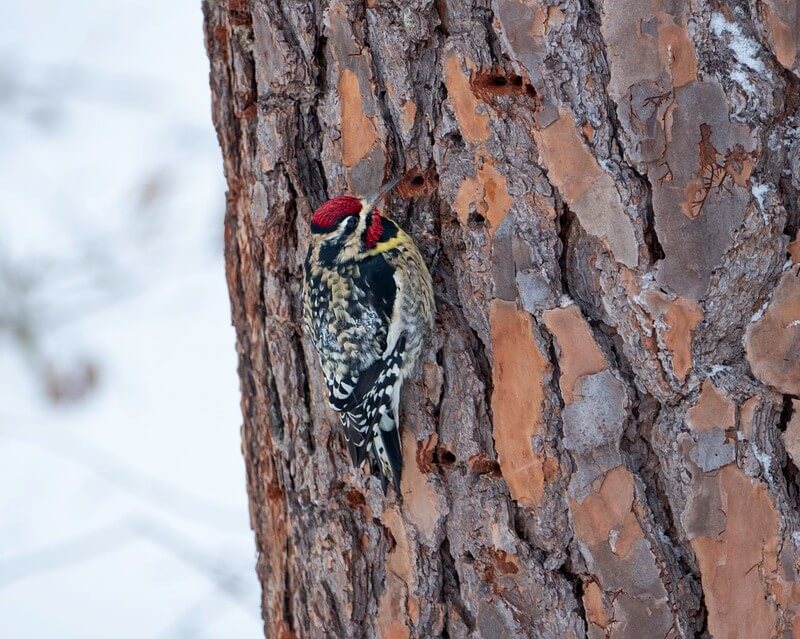Woodpeckers are a common sight in Alabama. These birds are found in a variety of habitats, from open fields to dense forests. They are especially prevalent in the southern part of the state, where they can be seen hammering away at trees in search of food. Woodpeckers are an important part of the state’s ecology, as they help to disperse seeds and create nesting sites for other birds. The geography of Alabama is varied and woodpeckers are able to take advantage of the different habitats. In the northern part of the state, woodpeckers can be found in deciduous forests, while in the south they are more likely to be found in pine forests. In the coastal areas, woodpeckers can be found in both salt and freshwater marshes. The diversity of habitats in Alabama allows woodpeckers to thrive and play an important role in the state’s ecology.
woodpeckers IN ALABAMA
Read on to learn more about the 8 woodpeckers that visit Alabama.
Downy Woodpecker

- Picoides pubescens
- Size: 6″ (15 cm)
Identification and Color: Adult Downies are black and white, with a black back, white belly, and a small patch of red on the back of the head. They have a short bill and a barred tail.
Habitat and Behavior: Downy Woodpeckers live in forests, woodlands, orchards, and suburban areas. They are year-round residents in most of their range. They forage on tree trunks and branches, using their bills and barbed tongue to peck at bark to find food.
Diet: Downies feed on insects, spiders, berries, and nuts. Downies sometimes store food by caching it in cracks in trees or other hidden spots. Can be spotted at seed and suet feeders.
What Does a Downy Woodpecker sound like?
Hairy Woodpecker

- Picoides villosus
- Size: 9″ (22.5 cm)
Identification and Color: The Hairy Woodpecker is a medium-sized black and white bird with a long bill, a small head, and a long tail. Males have a small red patch on the back of the crown.
Habitat and Behavior: Prefers a dense forest. These woodpeckers are fairly common in wooded areas across the United States. Hairy Woodpeckers are known to be very curious and will often explore their surroundings by pecking at trees and wooded objects. (Ideally trees and not your house!)
Diet: Mainly insects and insect larvae found in trees. Will also eat berries, seeds, and nuts.
What Does a Hairy Woodpecker sound like?
Northern Flicker

- Colaptes auratus
- Size: 12″ (30 cm)
Identification and Color: A fairly common large woodpecker, but size is where the similarities to other woodpeckers end. The male Northern Flicker is unique with a brown back, black bars and spotted breast. All North American Flickers have white rumps. There are also two different color groups of Northern Flickers – Yellow-shafted and Red-shafted. Yellow-shafted flickers have yellow underwings. Red-shafted flickers have reddish pink underwings.
Habitat and Behavior: Northern Flickers are hole-nesting birds, often making a home in a dead tree. Can be seen hopping around the ground while foraging or latched onto a tree eyeing a spot to search for food.
Diet: Northern Flickers mainly eat insects off the ground, but will also eat berries and nuts.
What does a Northern Flicker sound like?
Pileated Woodpecker

- Dryocopus pileatus
- Size: 15″ (38 cm)
Identification and Color: These birds are mostly black with white stripes on their faces and necks. Both males and females have a brilliant red crest on their heads, but only males have a red stripe on their cheek. The Pileated Woodpecker is fairly large and has a long neck. They have a long and chisel-like bill.
Habitat and Behavior: Residents of the northeast and southeast mainly. They do not generally migrate. Favors anyplace with many trees, may be found at dead trees or even young trees depending on location. They forage by pecking into trees which is very loud.
Diet: The Pileated Woodpecker mainly eats the ants found in trees. They will also eat other insects, fruits, and nuts.
What does a Pileated Woodpecker sound like?
Red-bellied Woodpecker

- Melanerpes carolinus
- Size: 9″ (23 cm)
Identification and Color: The Red-bellied woodpecker gets its name from the vaguely-visible reddish color on its belly, which is typically only seen when the bird is perched. They have a black and white striped back, white underparts, and a red nape.
Habitat and Behavior: The Red-bellied Woodpecker is a non-migratory bird, meaning it will stay in the same general area year-round. Forages for insects in trees or catches them in air. Can dominate other smaller woodpeckers and birds at feeders.
Diet: Consists mainly of insects and other invertebrates. Will also eat seeds, nuts and fruit.
What does a Red-bellied Woodpecker sound like?
Red-cockaded Woodpecker

- Dryobates borealis
- Size: 9″ (23 cm)
Identification and Color: A smaller woodpecker that is between 7 and 9 inches in length. Mostly black and white, they have a white cheek patch and white mark above the eyes with black on top of their heads. Underparts are white with black speckles, tops of the bodies are black with white bars.
Habitat and Behavior: Found throughout the southeast, where they are normally permanent residents. Prefers pine woodlands that are long-established with an open understory. They live in family groups and are very vocal.
Diet: The Red-cockaded Woodpecker mainly enjoys insects such as ants, beetles, and termites. They also eat fruits and some pine seeds.
What does a Red-cockaded Woodpecker sound like?
Red-headed Woodpecker

- Melanerpes erythrocephalus
- Size: 9″ (23 cm)
Identification and Color: Red-headed Woodpeckers have black backs, a large white patch and underparts, then black at the tip of the tail. Male adults have bright red heads. These birds are medium-sized woodpeckers and have rounded heads with powerful spear-like bills.
Habitat and Behavior: Red-headed Woodpeckers in northern and western areas usually migrate to southeastern states during the winter. Prefers open forests with cleared areas. Will forage by pecking trees, catching insects in the air, or on the ground.
Diet: Omnivorous diet consisting of berries, insects, and even some small rodents occasionally.
What does a Red-headed Woodpecker sound like?
Yellow-bellied Sapsucker

- Sphyrapicus varius
- Size: 8″ (20 cm)
Identification and Color: Males and females have red crowns with mainly black and white bodies. Males also have a red chin patch. Both have white and grey underparts with a little yellow. They have long wings and are smaller woodpeckers, between 7 and 8 inches.
Habitat and Behavior: Located throughout a vast area. They will breed in the far north, migrate throughout the central United States, and spend the winter in the south, going as far as Mexico. Prefers woodlands with mixed trees. They will forage by making small holes in trees.
Diet: The Yellow-bellied Sapsucker eats various insects, tree sap, fruit, or berries.
What does a Yellow-bellied Sapsucker sound like?
Conclusion
Woodpeckers are an important part of Alabama’s ecology. They are vital to the health of forests and are an important part of the food chain. They are also a source of enjoyment for birdwatchers and nature lovers. Woodpeckers are an integral part of the state’s natural environment and should be protected and preserved. With proper protection and management, woodpeckers can continue to be a part of Alabama’s natural landscape for generations to come.
Before you go, be sure to check out our other articles about birds in Alabama.






